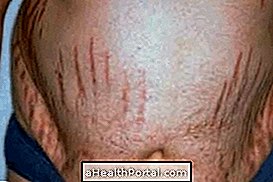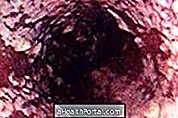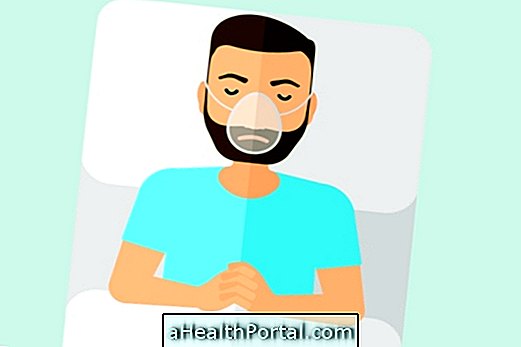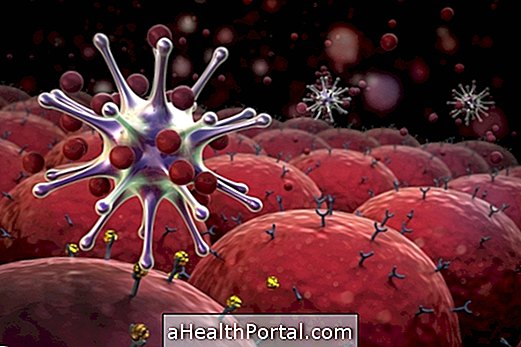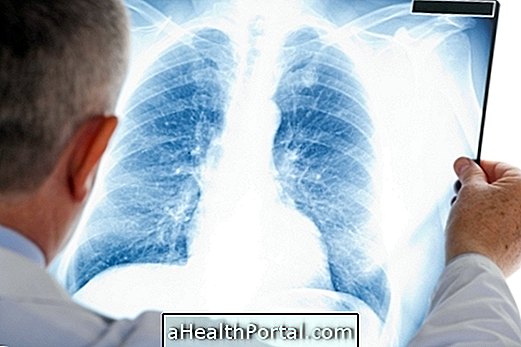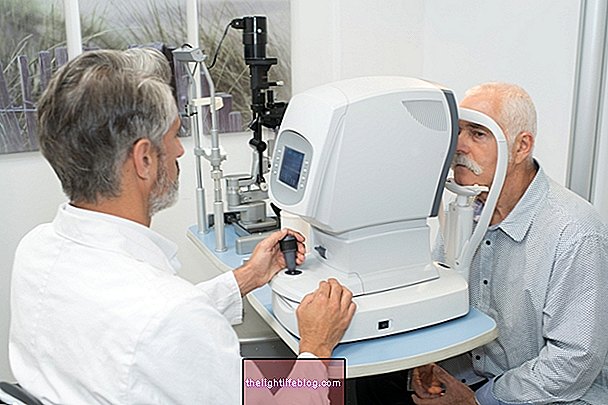Lymph node enlargement is the enlargement of lymph nodes that can happen in the face of any inflammation or infection, and even cancer. However, rarely, a tongue can indicate cancer, which is more common in people over 40 years of age.
Lymph nodes are small organs of the lymphatic system that are directly related to the body's defense system. Thus, when a ganglion, popularly called angler, is swollen or painful, this indicates that the immune system is fighting viruses or bacteria in the regions near that area.

Main causes of lymph node enlargement
Lymphadenopathy can be caused by inflammation, drug use, due to autoimmune disease or caused by the presence of viruses, fungi or bacteria, and as the causes are very varied, we cite here the most common causes of enlarged lymph nodes in certain parts of the body:
- Cervical lymph node enlargement - in the neck, behind the ear and near the jaw: pharyngitis, skin infection, conjunctivitis, mononucleosis, ear, mouth or tooth infection;
- Clavicular lymphadenopathy: toxoplasmosis, sarcoidosis, tuberculosis, gastrointestinal, breast, testis, ovarian, lung, mediastinal, lung or esophagus cancer;
- Inguinal lymphadenopathy: due to sexually transmitted diseases, such as syphilis, soft cancers, genital herpes, donovanose, cancer in the genital area;
- Axillary lymph node enlargement: silicone breast prosthesis infections, cat scratch disease, breast cancer, melanoma, lymphoma:
- Generalized lymph node enlargement : mononucleosis, juvenile idiopathic arthritis, dengue, brucellosis, chagas disease, rubella, measles, HIV, medicines such as fenine, penicillin, captropil.
The best way to know what is causing this enlargement of the lymph nodes is to go to the general practitioner and tell the doctor the presence of other signs and symptoms, as well as to see if the site is painful, its size, consistency, and signs of inflammation such as increased temperature, redness or pain.

Is lymph node enlargement cancer?
Although enlarged lymph nodes in certain areas of the body, being of great concern, when its size is smaller than 1 cm is unlikely to be cancer, especially in young people. Some signs and symptoms of lymph node enlargement may include:
- Location: Left supraclavicular lymph node enlargement, around the navel or armpits;
- Size: more than 2.25 cm;
- Consistency: Hard;
- Fixation: Widely adhered;
- Symptoms: No pain.
There is a higher chance of lymph node enlargement being cancer when the person has swelling in the lymph nodes located near the clavicle, affecting the left side of the body in people over 40 years of age, especially if there are cases in the family of breast, bowel, thyroid or melanoma.
The following table indicates the differences between the characteristics of cancer and inflammatory lymphadenopathy:
| Cancer | Other diseases |
| Swelling arises slowly | Swelling arises from day to day |
| Does not cause pain | It is quite painful to touch |
| Usually a single ganglion is affected | Generally, several nodes are affected |
| Irregular surface | Smooth surface |
| Must be more than 2 cm | Must be less than 2 cm |
In case of suspicion the doctor requests a biopsy puncture that can identify the lesion, and other tests that he deems necessary, depending on the symptoms that the person presents. Usually a biopsy is required when the ganglion is larger than 2 cm, located in the chest, which persist for more than 4 to 6 weeks, which grow slowly.
Childhood lymph node enlargement
The enlargement of lymph nodes in the neck, armpit or groin should always be investigated by the pediatrician. Some possible causes of this increase may be:
- Infectious diseases: Brucellosis, coxsackie, cat scratch disease, leprosy, herpes simplex, hepatitis, HIV, bacterial infection, upper respiratory infection, Leishmaniasis, mononucleosis, rubella, syphilis, toxoplasmosis, tuberculosis, tularemia;
- Autoimmune diseases: Infant idiopathic arthritis, rheumatoid arthritis, dermatomyositis, systemic lupus erythematosus, Sjogren's syndrome;
- Cancer: Leukemia, lymphoma, metastasis, cutaneous neoplasm, kaposi sarcoma;
- Other causes: Berylliosis, kawasaki disease, kimura disease, vaccine reaction, hyperthyroidism, sarcoidosis, silicosis.
When the child has symptoms of enlarged lymph nodes, one should take it to the pediatrician, where they will be asked for blood, x-ray, ultrasonography, tac or MRI scans, as well as others that the doctor may need, such as a biopsy.
Treatment can be done with antibiotics such as amoxicillin + clavulanate, cephalosporin to assess whether there is a reduction in size and signs that the lymph node is inflamed. Radiation therapy, chemotherapy and surgery may be needed in case of malignant lesions.




